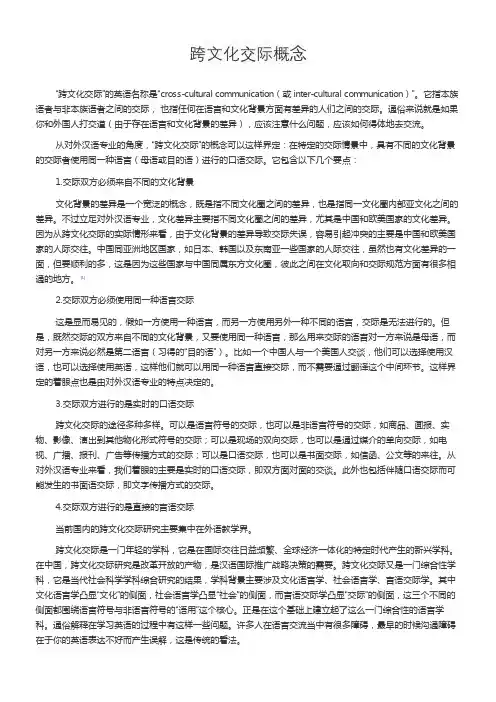跨文化交际翻译
- 格式:doc
- 大小:42.00 KB
- 文档页数:4

1. He’s just a green recruit fresh from college.缺乏经验的;不成熟的;幼稚的
翻译:他是个刚从大学毕业征召入伍的新兵。
2.I tried to call her many times but she was in a brown study and didn’t hear me.
深思,出神a state of deep absorption or thoughtfulness
翻译:我叫了她好几声,但她一直在沉思当中,并没有听见我的声音。
3. One day, out of the blue, a girl rang up and said she was my sister. 忧郁;沮丧;悲伤翻译:某天,出乎意料地,一个女孩给我打电话说她是我妹妹。
4. The new office block has unfortunately become an expensive white elephant.
累赘物,摆设物
翻译:这座新的办公楼步行地成了昂贵的摆设。
5.Mary was always regarded as t he black sheep of the family.
害群之马,败类,败家子
翻译:Mary总是被认为是败家子。
6. You’d better do something to prove you’re not yellow. 胆怯的
翻译:你最好做出点什么来证明你不是胆小鬼。
7.Can you see the green in her eyes? Green: adj. 由强烈感情影响的;嫉妒的。
翻译:你能看出她眼中的嫉妒之情吗?。

Unit 2With the amazingly rapid development in transportation and information communication, people from different cultures interact more often than ever before, but misunderstandings even conflicts caused in the process of this interaction also grow increasingly. Just for this reason, much concern is focused upon the problem of how to help people interact and communicate successfully in a transcultural way. As a matter of fact, culture is not strange to us all. We hear, read and talk of it, such as Chinese culture, English culture, tea culture, campus culture and so on. But when it comes to the meaning of culture, it is notoriously difficult to define what culture really is or should be.随着交通运输和信息交流的飞速发展,不同文化背景下的人们交往越来越频繁,但在交往过程中产生的误会甚至冲突也日益增多。
正因为如此,人们关注的焦点是如何帮助人们以跨文化的方式成功地进行互动和交流。
事实上,文化对我们大家来说并不陌生。
我们听、读、谈它,如中国文化、英国文化、茶文化、校园文化等。

Unit 2With the amazingly rapid development in transportation and information communication, people from different cultures interact more often than ever before, but misunderstandings even conflicts caused in the process of this interaction also grow increasingly. Just for this reason, much concern is focused upon the problem of how to help people interact and communicate successfully in a transcultural way. As a matter of fact, culture is not strange to us all. We hear, read and talk of it, such as Chinese culture, English culture, tea culture, campus culture and so on. But when it comes to the meaning of culture, it is notoriously difficult to define what culture really is or should be.随着交通运输和信息交流的飞速发展,不同文化背景下的人们交往越来越频繁,但在交往过程中产生的误会甚至冲突也日益增多。
正因为如此,人们关注的焦点是如何帮助人们以跨文化的方式成功地进行互动和交流。
事实上,文化对我们大家来说并不陌生。
我们听、读、谈它,如中国文化、英国文化、茶文化、校园文化等。

1、【communication across cultures】Chapter One Conceptual Foundation【跨文化沟通】第一章概念的基础Why study intercultural communication?为什么学习跨文化交际?There is a folk tale that comes to us from the foothills of the Himalayas. A man was trying to explain to a blind friend what colors are. He began with the color White.有一个民间的故事,来自于喜马拉雅山的山麓。
一名男子试图解释一个盲人朋友的颜色是什么。
他开始与雪白的颜色。
“Well,”he said, “it is like snow on the hills.”“嗯,”他说,“这就像雪在山上。
”“Oh,”the blind man said, “then it must be a wet and dampish sort of color, isn’t it? ”“No, no,”the man said, “it is also the same color as cotton or wool. ”“Oh yes, I understand. It must be fluffy color. ”“No, it is also like paper.”“哦,”盲人说,“那一定是湿,微湿的颜色,不是吗?”“不,不,”那人说,“这也是相同的颜色,棉或羊毛。
”“哦,是的,我明白了。
一定是毛茸茸的颜色。
”“不,它也像纸。
”“Then it must be a crackling or fragile color,”said the blind man. “No, not at all. It is also like china.”“那一定是脆皮或脆弱的颜色,”瞎子说。

跨文化Chapter 1P1~2Chapter 1 前三段判断题范围THE ONLY TIME WHEN TRUE SUFFERING OCCURS ISWHEN TWO CULTURES COLLIDE. —— HERMANN HESSE只有苦难发生,当两种文化碰撞时。
anyone who has done business internationally knows that dreadful feeling brought on by the blank stares,任何人做国际业务的都知道,空洞的眼神所带来的可怕感觉,the forced half-smiles, the murmured comments in a language that seems indecipherable—强迫半微笑,用似乎难以辨认的语言低声评论——when what you say doesn't connect, and when something seems missing.当无法和你说什么事情联系上时,有些事情似乎就错过了,The paranoia is inescapable. You had your checklist of cultural do's and don'ts and followed them religiously.偏执是不可避免的。
你有你的该做什么和不该做什么的文化清单,并且虔诚地遵守着。
You broke no taboos, committed no cultural faux pas, insulted no one—yet you failed to break through. Why?你不打破任何禁忌,不犯任何文化失礼,不侮辱任何人——但你却未能突破文化差异。
为什么呢?Distance and time were once the biggest obstacles to doing business internationally.距离和时间,一度成为做国际业务的最大障碍。

张桂萍跨文化交际第六单元课文翻译Unit 6 Page 215
非言语交际被认为是不直接依靠语言使用的任何交际方式。
然而,一般来说,很难知道言语交际方式与非言语交际方式的区分到底在哪儿。
有些非言语交际方式,例如点头,总是伴随着言语,而且是语言使用时言语系统的一部分。
另一方面,像舞蹈和音乐等交际形式常常是没有任何言语成分的。
我们在这里想做的只是要引起大家对一个事实的注意,即人类交往的许多方面都依赖于那些不能轻易转换为言语、但却对我们相互理解至关重要的交际形式。
当然,我们不能不强调口语和书面语交际的重要性,然而我们也必须意识到许多交际的发生并不使用语言。
一个人出席会议时的穿着会可能是暗示其他与会者,他或她打算如何参与会议。
事实上,我们能运用我们行为或表现的任何方面来和他人进行交际。

跨文化交际概念“跨文化交际”的英语名称是“cross-cultural communication(或inter-cultural communication)”。
它指本族语者与非本族语者之间的交际,也指任何在语言和文化背景方面有差异的人们之间的交际。
通俗来说就是如果你和外国人打交道(由于存在语言和文化背景的差异),应该注意什么问题,应该如何得体地去交流。
从对外汉语专业的角度,“跨文化交际”的概念可以这样界定:在特定的交际情景中,具有不同的文化背景的交际者使用同一种语言(母语或目的语)进行的口语交际。
它包含以下几个要点:1.交际双方必须来自不同的文化背景文化背景的差异是一个宽泛的概念,既是指不同文化圈之间的差异,也是指同一文化圈内部亚文化之间的差异。
不过立足对外汉语专业,文化差异主要指不同文化圈之间的差异,尤其是中国和欧美国家的文化差异。
因为从跨文化交际的实际情形来看,由于文化背景的差异导致交际失误,容易引起冲突的主要是中国和欧美国家的人际交往。
中国同亚洲地区国家,如日本、韩国以及东南亚一些国家的人际交往,虽然也有文化差异的一面,但要顺利的多,这是因为这些国家与中国同属东方文化圈,彼此之间在文化取向和交际规范方面有很多相通的地方。
[1]2.交际双方必须使用同一种语言交际这是显而易见的,假如一方使用一种语言,而另一方使用另外一种不同的语言,交际是无法进行的。
但是,既然交际的双方来自不同的文化背景,又要使用同一种语言,那么用来交际的语言对一方来说是母语,而对另一方来说必然是第二语言(习得的“目的语”)。
比如一个中国人与一个美国人交谈,他们可以选择使用汉语,也可以选择使用英语,这样他们就可以用同一种语言直接交际,而不需要通过翻译这个中间环节。
这样界定的着眼点也是由对外汉语专业的特点决定的。
3.交际双方进行的是实时的口语交际跨文化交际的途径多种多样。
可以是语言符号的交际,也可以是非语言符号的交际,如商品、画报、实物、影像、演出到其他物化形式符号的交际;可以是现场的双向交际,也可以是通过媒介的单向交际,如电视、广播、报刊、广告等传播方式的交际;可以是口语交际,也可以是书面交际,如信函、公文等的来往。

跨文化部分要点翻译注:不是所有划出部分都翻译了。
配套的有Chapter 2的翻译。
P28The Value of Cultural Stereotypes文化角色定型的价值Culture dictates how people generally think and interact with each other in society.文化造成人们的普遍怎么认为和在社会中的互动。
A stereotype is really a composite of the cultural mores of a society and in many cases can be narrowed to a specific region.角色定型实在是一个综合的社会文化习俗,而且,在许多情况下它可以被缩小到一特定区域。
To stereotype is to formulate a standardized image of a group that assigns that group a number of characteristics that helps to simplify what would otherwise be a very complex task of identification.角色定型,是制定一个组的标准化形象,分配给该组一些特点,有助于简化原本非常复杂的鉴定任务。
By looking at the cultural components and traits, an accurate model—a stereotype, if you will—of how an individual from a certain culture is likely to act can be constructed.通过观察文化内容和特点,一个准确的模型——一个角色定型,如果你可以——可以从一个特定文化的个体可能如何行动这方面来构造。

fully by letter, telephone, fax or e-mail in such cultures. It is not necessary to meet face-to-face with a colleague to get things done.完全在这种文化的信函,电话,传真或电子邮件。
满足面对面与同事把事情做好是没有必要的。
High-context cultures are the exact opposite. Communication tends to be imprecise and as much attention is paid to the person delivering the message as to the message itself. In high-context cultures---most of Latin America, Asia, the Middle East and Africa---personal encounters are essential before business can begin.高语境文化是完全相反的。
沟通往往是不精确的,对提供消息的人比对消息本身关注的更多。
高语境文化中---大多数拉丁美洲,亚洲,中东和非洲---个人遭遇实在业务开始之前必不可少的。
These people need as much ancillary information as possible. They pay more attention to physical surroundings, how a business colleague is dressed or coiffured---the general ambiance of the negotiations---than individuals from low-context countries. Body language, facial gestures and voice inflection are important methods of communication. The physical surroundings for a meeting or a business meal are just as important as the substance of the discussion.这些人需要尽可能多的辅助信息。

第一单元语言:汉语与英语Section A 汉语Passage 1 中文的方方面面1汉语是汉藏语系的一个分支,由数百种地方语言组成,其中许多语言互不相通。
据估计,10多亿人的第一语言是某种形式的汉语作。
历史2古汉语是经证明最古老的汉语,是所有现代汉语变体的始祖。
从先秦到晋代都使用过古文。
中国最早的文字记载出现在3000多年前,最早的例子是商代末年甲骨上的占卜铭文。
在随后的周朝,青铜器铭文变得丰富起来。
周朝后半期文学繁荣发展,包括《论语》、《孟子》、《春秋》等经典著作。
这些作品都是文言文的典范。
3中古汉语是南北朝和隋唐宋时期使用的语言,可以分为以韵书《切韵》为标志的早期中古汉语,和以切韵系统的指南“韵表”为标志的晚期中古汉语。
中古汉语是恢复早期汉语发音的口传的起点。
4北宋灭亡后,在晋朝和元朝时期,中国北方出现了一种通用语(现在称为旧官话)。
明清时期的官员们使用基于普通话变体的“官话”来管理国家。
在明清时期的多半时间里,这种语言是以南京地区的方言为基础的,但与任何一种方言都不完全相同。
到1909年,即将灭亡的清朝将北京话定为“国语”5中华人民共和国继续推行共同的国语,于1956年正式确定了中国的标准语言。
普通话是现代汉语的标准形式,以北京语音系统为发音规范,以北方方言为方言基础,以白话文学语言为语法规范。
在中国,普通话现在被用于教育、媒体和正式场合。
汉语是联合国六种官方语言之一。
发音7 汉字不能可靠地指明其发音。
因此,对于那些不识汉字的人来说,将汉语音译成拉丁字母是很有用的。
拼音系统是在20世纪50年代由许多语言学家在早期汉语罗马化形式的基础上发展起来的。
1958年由中国政府出版,并多次修订。
国际标准化组织(ISO)于1982年将拼音作为一项国际标准,随后于1986年被联合国采用。
8声母和韵母构成拼音的基本要素。
普通话的每个音节都可以用一个声母后跟一个韵母拼写,或者在某些情况下只有一个韵母,但特殊音节er或后缀-r被视为音节的一部分时除外。

关于跨文化交流,跨文化市场才是第一的真正的首要的范本。
考虑到古罗马帝国的市民,他们是第一个诞生商店的地球文明。
商人们通过在商店的上面树立旗帜来展示他们商品货物的图片来解决跨文化市场的困扰。
这种做法不仅能为罗马帝国中未受过教育的市民服务还能帮助罗马商人们获得被他们用武力征服的殖民地的商业信息。
回顾过去,我们会发现两千多年前的亚里士多德曾明确说过:“有效劝服基本的信念仍可以把他应用到今天的买卖商品上然而在古代的雅典可能会引起一场大的争论”。
很明显的可以看出,交流是现代市场的根基。
毋庸置疑,全球化市场的时代已经到来。
每年超过4万件的商品货物进入国际市场,其中超过一半是来自美国。
这里面85%的商品都不合格。
通往国际化市场成功的道路是建立在失败的市场垃圾碎片和广泛的广告活动之上的。
他们中的大多数之所以会失败,是因为跨文化交流被曲解了。
在跨文化市场里,如果你想把低劣的语言举止降低到最小,那么就不假定任何事情。
几乎我们都听说过关于美国通用汽车公司,他们尽力想把他们的雪佛兰牌汽车销往拉美国家。
但是雪佛兰在说西班牙语的拉美国家按字面意思是不能行走。
当公司发现汽车买不出去的原因时,他们就把车重新命名,然后销往这些国家。
福特汽车公司,美国又一个汽车界的领头羊,也有类似的问题。
他们的pinto 牌汽车在当地也没有达到预期的销售,原因时他们的汽车其意思在当地为男性生殖器。
最终福特公司把所有的名牌汽车重新命名为corcel,其意思为骏马。
伊莱克斯,一个日用电器制造者,其在英国获得了很大的成功。
不幸的是,他们的广告招牌的意思在美国和英国大不相同。
在美国,suck的意思是多虱子的。
英国的牙膏生产商在法国制造出来了一种牙膏叫cue。
它被人们所耻笑。
因为它的名字使人想起了臭名昭著的色情杂志——Cue。
但是市场中的文化意识更多于细心的翻译。
每一文化都有其微妙之处,当然也有其鲜明的禁忌。
尽管大多数的人不能列出他们自己文化的规则,但是他们很明白什么时候这些禁忌被触碰了。
Unit 5Nonverbal communication课前谚语+名言:1、I’s not what he said, but the way he said it.——English saying2、There is a language in her eyes, her cheeks, her lips.——William Shakespeare案例一:个人空间马克最近从丹麦搬到了悉尼,在一家澳大利亚公司当销售员。
他被邀请加入当地的一个俱乐部。
有一天在一个晚会上,一个女成员走近他,马克立即通过谈论展现出了他的兴趣。
起初聊天进行的很顺利,但随着谈话的进行,马克逐渐的向她靠近,而那位女士似乎离他越来越远,并显得很不自在。
当马克正要问她有关于澳大利亚习俗的问题时,站在旁边的一个男士往这边瞟了一眼,她找了个借口离开,去和那个男人说话。
留下马克傻傻的站在那里,他不知道为什么他们的交谈如此突然地停止了。
Question:Why did that women suddenly stop talking with mark and turned to another man?注释:这是一个对身体距离理解不同造成的误会。
在丹麦,正式场合中,个人空间大概在20厘米-30厘米之间。
而在澳大利亚,这样的场合需要40厘米-50厘米的身体距离。
所以丹麦人习惯近距离交谈,澳大利亚人习惯远距离交谈。
在这个情况下,马克尝试去建立自己正常的个人亲密空间,侵犯了澳大利亚女士的空间,正因如此,她感到了某种威胁,失去了舒适感。
就在那时,身旁的男人给了她一个离开的机会。
如果马克对于澳大利亚人所期待的个人空间有所了解的话,或许这个谈话会有所不同。
案例二:使用当地语言的问题。
弗兰克为了做研究的目的从澳大利亚来到中国,为此,他在大学里刻苦学习中文,并且能用中文很方便的和人交流。
而当他到达北京以后,他开始和当地人交谈,询问方向和建议。
尽管他几乎都是用中文和他们交流,但是他发现周围的人有时候会笑着用英语回答他,尽管他们对英语知之甚少。
Unit Two Task 11)A smooth sea never made a skillful mariner. 平静的大海决不能造就出熟练的水手。
/花盆里生长不出参天大树。
/温室里长不出栋梁之才。
2)He who would search for pearls must dive below.不入虎穴,焉得虎子。
/ 欲寻珍珠就要潜到水里。
/ 欲寻珍珠欲潜入水。
3)Living without an aim is like sailing without a compass. 生活没有目标如同航行没有罗盘。
/没有目标的生活如同没有罗盘的航行。
4)To have another fish to fry另有要事/ 另有事情得做5)The water that bears the boat is the same that swallows it up.水能载舟,亦能覆舟。
(The same knife cuts bread and fingers.)6)前人栽树,后人乘凉。
One sows and another reaps. / One man sows and another reaps. / One generation plants the trees in whose shade another generation rests. / The precedence planted, the later generations enjoy its cool.7)斩草不除根,逢春又发青。
If the grass is only cut, then the next spring it will revive. / Cut weeds and dig up the roots.8)种田不用问,深耕多上粪。
Planting has no better measures but ploughing deeply and fertilizing much more.9)生米煮成熟饭。
landscape engineer园林工人tonsorial artist理发师sanitation engineer清洁工shoe rebuilder 补鞋匠soft in the head发疯的reckless disregard for truth说谎to take things without permission偷窃industrial climate劳资关系紧张nether garments下面穿的衣服trousers裤子plain(朴素的;简单的ugly丑陋的patient耐心的lunatic疯狂的call your carriage for you=ask you to go away请你离开a man of doubtful taste=a man of doubtful taste一个低级趣味的人a lady of the town=a prostitute妓女(镇上的女人)Justice has long arms.天网恢恢,疏而不漏Diamond cut diamond.棋逢对手golden saying金玉良言fat office肥缺You will cross the bridge when you get to it.船到桥头自然直Better be the head of a dog than the tail of a lion.宁为鸡头,不为凤尾drink like a fish牛饮tread upon eggs如履薄冰Kill two birds with one stone.一箭双雕Haste makes waste.欲速则不达Beauty is only skin deep.美貌是肤浅的Spare the rod and spoil the child.玉不琢不成器Give a person a dose of his own medicine.以其人之道还治其人之身Frank’s advice is like good herbal medicine: hard to take, but ultimately beneficial.良药苦口利于病,忠言逆耳利于行An apple a day keeps the doctor away.一天一苹果,医生远离我Let sleeping dogs lie.莫惹是非You can’t teach an old dog new tricks.年逾花甲不堪教You can’t have your cake and eat it too.鱼与熊掌不可兼得Gilding the lily.画蛇添足(此文档部分内容来源于网络,如有侵权请告知删除,文档可自行编辑修改内容,供参考,感谢您的配合和支持)。
no one when he uses a word has in mind exactly the same thing that another has ,and the difference, however tiny, sends its tremors throughout language在用词达意方面没人想的会和他人一样/每个人想的都不一样,而这些差别,不论其多么微小,都会在语言中造成一连串的影响.The American nuclear family usually has its own separate residence and is economically independent of other family members. Relatives are still considered "family" but are often outside the basic obligations that people have to their immediate families.美国的小家庭往往有独立的居所,而且经济独立于大家庭的其他成员。
亲戚也被认为是“家庭”的一份子,但是并不需要承担像对直系亲属那样的责任。
The independence from parents is not an indication that parents and children do not love each other. Strong love betweenparents and children is universal and this is no exception in the American family.独立于父母并不意味着孩子和父母之间不相亲相爱。
父母和子女之间浓厚的爱是普遍的,在美国家庭也不例外。
No formal initiation in the U.S. through which young people pass from childhood to adulthood. There are, however, cultural practices that signify maturity and cultural contexts that have particular significance for the transition from youth to adulthood. 在美国,年轻人从孩提时代到长大成人没有正式的仪式。
Speaki ng Englis h with a Japane se mind 日本人在达到上学年龄后就要学英语,这些人在学会英语之后就可能用英语进行对外交流,但是他们所使用的英语要受到他们本民族的语言和文化的影响。
因此这就会造成困扰和误解在与其他用英语的人交流时。
AM,当他作为索尼公司的首席执行官时,在一次给美国的商学会做报告时他指出了这两种语言的明显差异。
他举了一个例子,一个美国商人向他的一个日本生意上的伙伴提议了一项计划。
可是当美国人完成时,日本人才开始谈论这个项目听起来多么有趣并且他们公司也有同样的想法。
美国人认为这个项目肯定会被接受。
但是随着辩论的拖延,美国人的关注也开始减弱,然后日本人说,不管怎样。
AM告诫说,接下来就是你要仔细听的时候了。
因为真正的回答是在那个词语的后面。
他经常告诫他的部下官员要用一种大多数的使用英语的人都习惯的方式说话,如果他想被别人理解。
他还告诫说,在日本你可能是大多数,但是到了国外你就是一小部分。
要想用一种大多数人都能最大限度的理解你的方式说话需要更多的语法知识和大量的词汇。
你必须对你所谈话的那个人的交流方式,社交礼仪,价值观等等很熟悉。
日本人的说话顺序正好和说英语的人相反。
甚至就是一个非常简单的句子,比如英国人会说,你得带伞因为要下雨。
而日本人会说,因为会下雨所以你要带伞。
不管这种正常的表达方式的顺序是否会控制想法顺序还是什么,日本人这种用不同顺序的表达信息的方式会让那些说英语的国家的人且对日本语言不了解的人感到困惑。
另一个例子就是,一些说英语的日本人和美国的一些领导举行卫星电视会议来讨论两国间的经济和贸易关系。
日本的参会者说着流利的英语,同时会被翻译成日语以供那些不懂得英语的人理解。
题名/责任者/语种:跨文化交际翻译/金惠康著/中文
出版发行/载体形态:北京:中国对外翻译出版公司,2003 /402页;20厘米ISBN/装订形式/定
价:
ISBN:7-5001-1010-3/23.00元
索书号:H315.9/8050
丛编:翻译理论与实务丛书.-()
附注:“十五”国家重点图书
附件:
文摘或提要:本书以实例描写为主,配以适量的理论指导与分析,收集了近二十年来大陆、港、台、澳及海外华人的精彩汉英翻译例证,形成了一个比较统一、规范的汉英对译系统。
跨文化交际翻译
作者:金惠康
书摘
a sea oI people/flames/blood/flags/flowers/happy faces如海般的/如潮一样的人群;火海;血海;旗海;花海;无数幸福的面孔
an ocean of trouble/time/space/cheering
无穷的麻烦;无休止的时间;浩瀚的宇宙;欢乐的海洋
a scene of great rejoicing一片欢腾
a chorus of protest/praise一片抗议之声/赞扬之声
a trove of Chinese porcelain一批中国磁器
a grove of coco(a)nut/hamboo一战挪椿}镌椿
a blaze of lights一片灯火
a mountain of debts/rubbish/money/dirty clothes
债台高筑/gr圾如山;家财万贯;一大堆脏衣服
a mass of images/facts/figures/data大量的图像/事实/数据等
a rain/storm of tears/ashes/arrows/bullets嚎啕大哭;尘土蒙蒙;一阵箭雨,一阵弹雨
a storm of applause/criticism/cheering
一阵暴雨般的掌声;激烈的批评;狂热的欢呼
a gale oflaughter/excitement阵阵欢笑;一阵激动
a flood of tears/words/light/terror
泪如潮涌;滔滔言辞;一片光明;一片恐惧
a store oflearnlng/experience知识渊博;经验丰富
a wealth of experience/data/troubles/good/goods
经验丰富;丰富数据;问题多多;大有好处;商品丰富
a sudeit offood/drug dosage
过量的食品;过量的药品
a succession of defeat接二连三的挫败
a world of goods/food/pleasure/meaning/to do s
b a
world of good/harm
a forest of hllls/nags/chimneys/hands
这些表量的手法也可用复数,像10ts of,tho。
d。
f一样.如seas。
f,mountains。
f,st。
r es。
f,swamls。
f,thunders。
f。
sh。
wers of,in showers,in stores,in numbers。
a(great)number of books许多的书
numbers of peoples许多的民族
a quantity of energy大量的能量
quantities of oxidize大量的氧化酶
an amount of material大量的材料
small amount of water少量的水
l he。
mount of energy possessed by a given quantity of radiation depends strictly on it s frequency.一定量的辐射所掘有的能量完全基于其频率。
The total amount of radiation辐射的总量
What’S the size?尺码多少?
What’s the linear size of the Galaxy?
银河系的直线长度是多少?
the linear dimensions直线尺寸
all sizes of gloves各种尺码的手套
(in)all shapes and sizes大大小小,各式各样
(in)life size(如)实物大小
What are the dimensions of the room?
这房间的长、宽、高各多少?
the dimensions ofthe solar system太阳系的范围
the dimensions of a building lot
一座建筑物的准确面积
the magnitude of this angle这角度的大小
the value of the balloon气球的体积
the value 0f this correction修正值
the extent of a judge’s power/his knowledge
法官的权力范围/他的知识面
be...in length/w.dth/height/diameter/perimeter/shape/size
be .in quantity/am。
unt/great numbers/extent/dimension/value
第二章汉英表达的不同
(Different Ways of Expressing Ideas)
2.1 汉英不同的说法(Different Ways
of Saying Thing)
由于归属不同语言体系和拥有不同的文化背景,汉英各有其独特的表达方式,形成不同的思维定式和价值评判标准。
这使得语言学习,特别是外语学习困难重重。
在母语中养成的言语直觉在另一种语言中可能毫无用处,甚或造成障碍。
例如中文说“我送您到大门”,英语说:I’ll see you to the gate.翻译时难免要犯些个错误。
不仅在遣词造句、词语搭配、惯用语等方面,在文体、修辞和褒贬方面也一样容易出差错。
如下面的例子:(括号中词语为正确用法)
If you like riding,there are horses you can rent.(hire)
My favorite play is chess.(game)
The person sitting next to the driver was full of mud
(covered in mud)
2.1.1表达习惯的不同(Different Ways of Saying Things)
汉英是两种完全不同的,各具典型的东西方文化特征的语言,其间差异巨大,以表达方式为例,便可见一斑。
下面是我们翻译时容易弄错的搭配:
大雪heavy snow(而不习惯说big snow)
红茶black tea (而不习惯说red tea)
红糖brown sugar (而不习惯说red sugar)
浓茶strong tea (而不习惯说thick tea)
浓墨thick/dark ink (而不习惯说strong ink)
浓汤thick soup (而不习惯说strong soup)
浓烟heavy/dense smoke
(而不习惯说strong smoke)
喝汤eat soup (而不习惯说drink soup)
丢脸lose face (而不习惯说lose one’S face)
发脾气lose temper(而不习惯说lose one’s temper)
露一手show a hand(而不习惯说show one’s hand)
红眼病green—eyed (而不习惯说red-eyed)
减肥lose weight(而不习惯说lose one’S weight)
哭穷poor—mouth (而不习惯说pretend to be poor)
……。